Key takeaways:
- Selective mutism is an anxiety disorder affecting children’s ability to speak in certain social situations, often exacerbated by sensory overload and fear of judgment.
- Creating sensory-friendly environments, with calming colors, soft lighting, and minimal noise, is essential to reduce anxiety and facilitate communication for affected children.
- Personal experiences highlight the transformative power of supportive spaces that encourage expression and connection without the pressure of traditional communication methods.
- Practical tips for creating sensory-friendly environments include using soft textures, limiting auditory distractions, and incorporating natural elements to foster a calming atmosphere.

Understanding selective mutism
Selective mutism is a complex childhood anxiety disorder that impacts a child’s ability to speak in certain social situations, despite having the capacity to speak comfortably in others, often in familiar environments. I remember a friend’s daughter who would shine when at home, her laughter filling the room, but once they stepped into her classroom, she would retreat into silence. It made me wonder, what goes on in a child’s mind when they hold back their voice?
The triggers for selective mutism can vary widely, from overwhelming sensory inputs in busy settings to fear of judgment from peers. I recall a day spent in a chaotic mall where the noise and bright lights seemed to engulf everything, leaving me feeling utterly drained. I realized then that for some children, this sensory overload can be crippling, leading to a spiraling retreat into silence. Could a child truly find solace in a world that constantly bombards them?
Understanding selective mutism requires an empathetic lens—recognizing that it’s not simply shyness but a legitimate response to anxiety and sensory challenges. One evening, while discussing the topic with parents, we shared our frustrations and triumphs, ultimately connecting through our stories. This made me reflect: How can we create environments that offer a safe space for children to express themselves when words fail them?
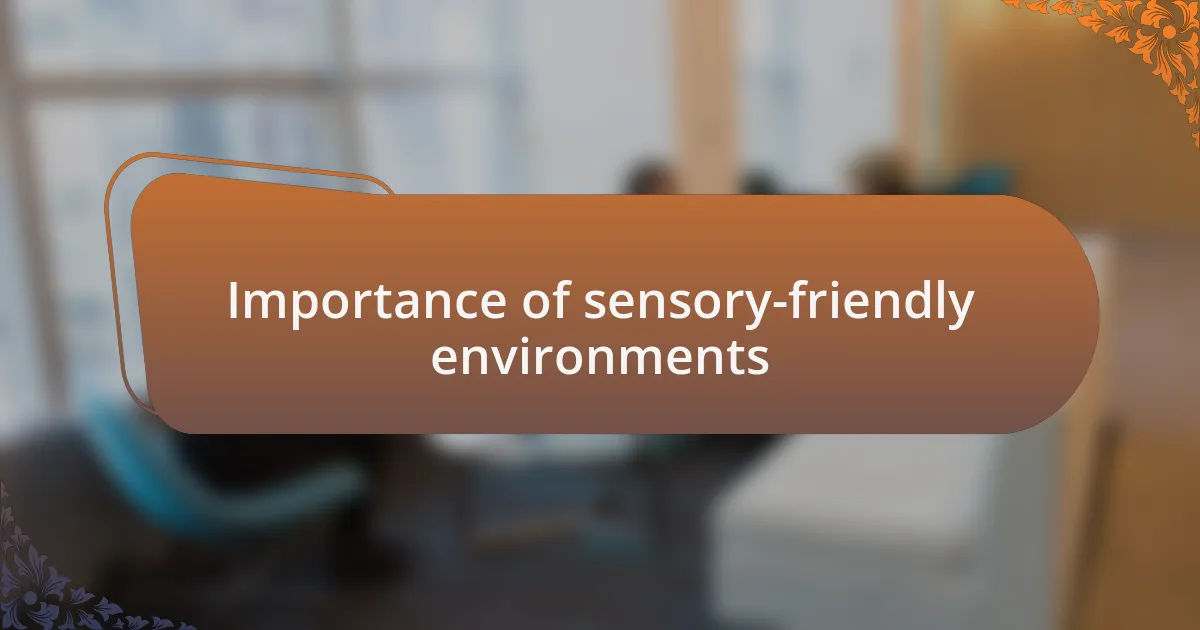
Importance of sensory-friendly environments
Creating sensory-friendly environments is crucial for children experiencing selective mutism as these safe spaces help reduce anxiety and facilitate communication. I recall a visit to a local library that had designated quiet zones. The calm atmosphere, with soft lighting and minimal distractions, made it easier for me to focus and interact with others. Can you imagine how a child might feel in such a nurturing space?
When sensory inputs are minimized, children can slowly find their voices. I once observed a workshop designed for children on the spectrum, featuring calming visuals and textured materials. As the workshop progressed, I noticed kids engaging more freely, their laughter lifting the once-stifling atmosphere. It struck me that the right environment could be the key to unlocking a child’s ability to communicate.
In contrast, I vividly remember a crowded birthday party filled with loud music and chaotic energy. It overwhelmed not just the children, but also the parents. Watching the kids shrink away from interaction made me question: How often do we overlook the impact of our surroundings on a child’s willingness to speak? Creating sensory-friendly environments isn’t merely a nice-to-have; it’s essential for fostering communication and emotional safety.
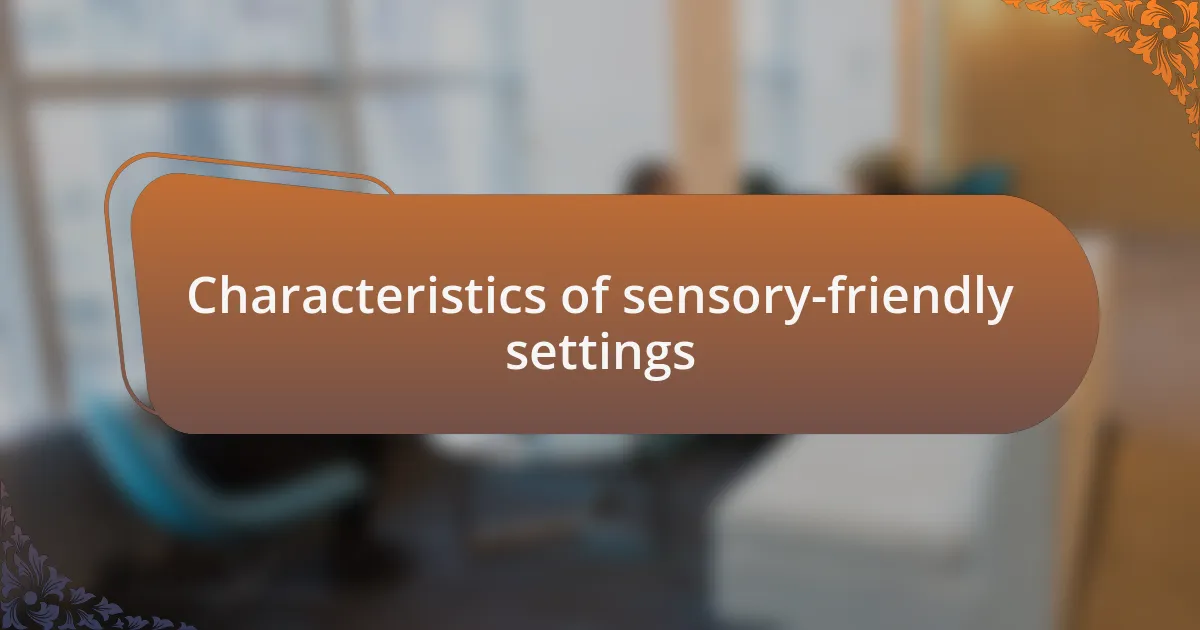
Characteristics of sensory-friendly settings
Sensory-friendly settings often feature soft lighting, such as dimmed bulbs or natural daylight, to create a soothing environment. I remember attending a quiet art exhibit where the gentle illumination allowed me to take in the artwork without feeling overwhelmed. How often do we underestimate the power of light in shaping our experiences?
Another key characteristic is the use of calming colors and textures. In a sensory-friendly classroom I visited, the walls were painted in soft pastels, and the furniture was comfortable and inviting. I could feel the tension melt away the moment I stepped in. It’s fascinating to think about how color psychology might influence a child’s mood and engagement.
Sound is equally important in these environments. For instance, I’ve been to play spaces that used soundproofing materials to minimize distractions, which allowed children to converse without shouting over one another. In these moments, I genuinely felt the difference a peaceful soundscape can make. Have you ever noticed how silence can be just as powerful as sound?
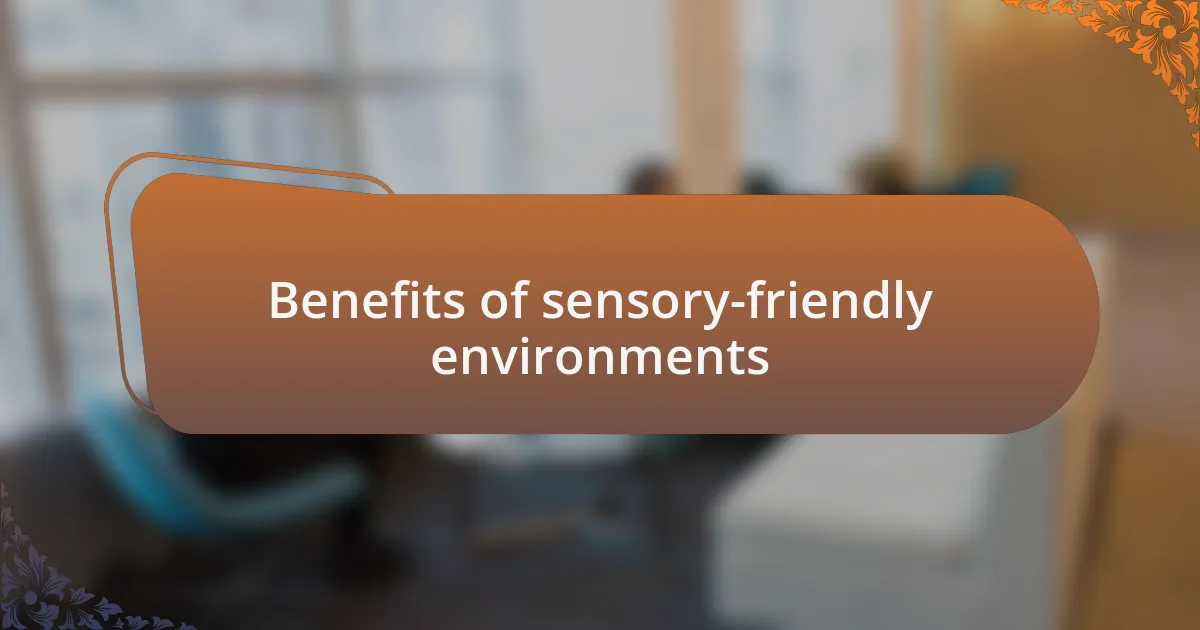
Benefits of sensory-friendly environments
Creating sensory-friendly environments provides numerous benefits, especially for individuals with selective mutism or sensory sensitivities. I recall visiting a community center that incorporated quiet zones filled with soft furnishings and minimal distractions. It struck me how much more relaxed I felt, allowing me to engage openly in conversations without feeling the pressure of overwhelming stimuli. Can such simple adjustments really empower communication?
Such spaces can foster social interaction and emotional safety, promoting a sense of belonging. One time, I participated in a small group activity in a sensory-friendly setting that encouraged everyone to share without fear of judgment. The gentle atmosphere made it easier for participants to express themselves. It made me wonder: how much can our environments shape our willingness to communicate and connect?
Additionally, sensory-friendly environments often reduce anxiety and sensory overload, which are significant barriers for many. I’ve seen firsthand how children flourish in dedicated spaces designed with their needs in mind. When they can explore freely, without the usual stressors, it’s remarkable how much their confidence can grow. Isn’t it inspiring to think that a thoughtful design can lead to such profound changes in behavior?

My journey with selective mutism
I still remember the early days of my journey with selective mutism. There were moments in elementary school when simply saying my name felt like a monumental task. I often found myself staring at the ground, wishing for the earth to swallow me whole as classmates chatted away, their voices a distant buzz that seemed both comforting and terrifying. How could a single word feel so heavy?
As I navigated through years of silence, I often felt trapped in a bubble, yearning to connect but unsure how. There were instances when friends invited me to join conversations, only for my voice to become lodged in my throat. In those moments, the frustration was palpable, leaving me questioning whether I would ever truly belong. Did they understand my struggle, or was I just an enigma?
The turning point came when I discovered supportive environments, spaces that understood my unique needs. In one memorable setting, a teacher initiated small, guided discussions, gradually easing the tension. The gentle recognition of my struggles transformed those moments into opportunities for connection. It made me realize that communication often thrives not just on voice but on understanding and compassion. Wouldn’t it be wonderful if more people could create such nurturing spaces?
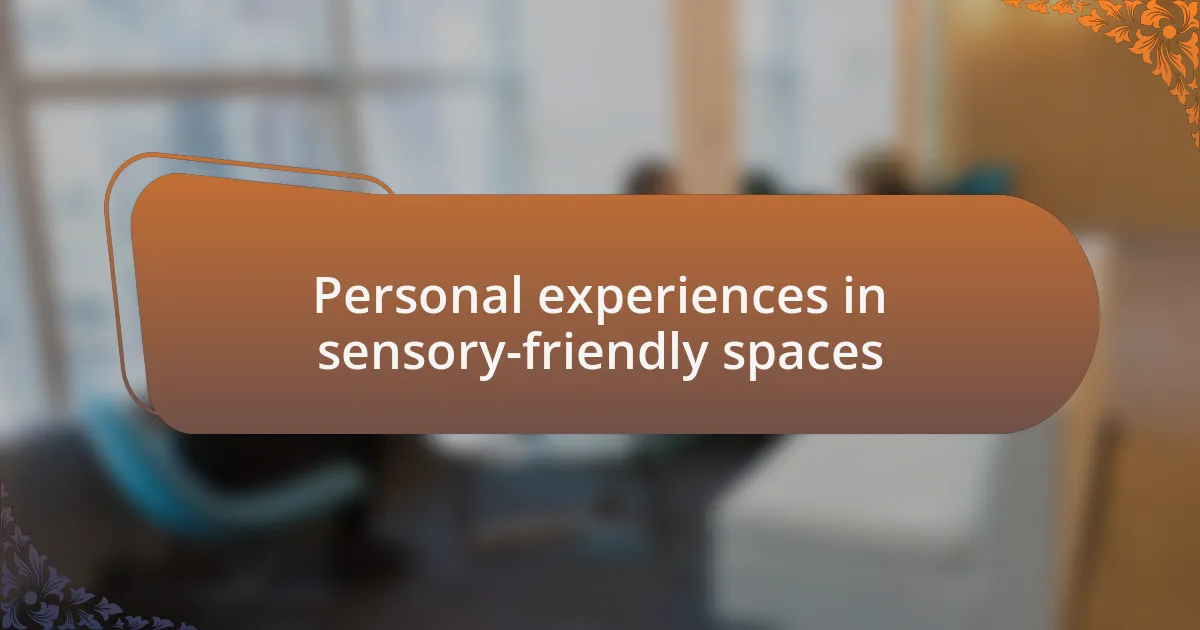
Personal experiences in sensory-friendly spaces
I remember my first experience in a sensory-friendly space vividly. Walking into a quiet room with soft lighting and soothing colors felt like stepping into a warm embrace. It was in a community center designed for individuals like me, and the gentle hum of white noise melted away the chaos in my mind, allowing me to breathe a little easier. Have you ever felt such an instant sense of relief upon entering a place that just gets it?
In another setting, I attended a workshop specifically crafted for those with sensory sensitivities. The organizers provided fidget toys and calming scents, creating an atmosphere where I could let my guard down. As the facilitator encouraged us to express our thoughts through drawing rather than speaking, I felt a rush of creativity I hadn’t experienced in ages. It was liberating; I wondered how many others could benefit from such innovative approaches to communication.
Participating in these sensory-friendly spaces helped me realize the power of inclusivity. One day, while sharing my artwork, I noticed a fellow attendee nodding along, clearly connecting with my experience. It was a profound moment—one where we both felt understood without the need for words. Isn’t it fascinating how sometimes silence can speak volumes in the right environment?
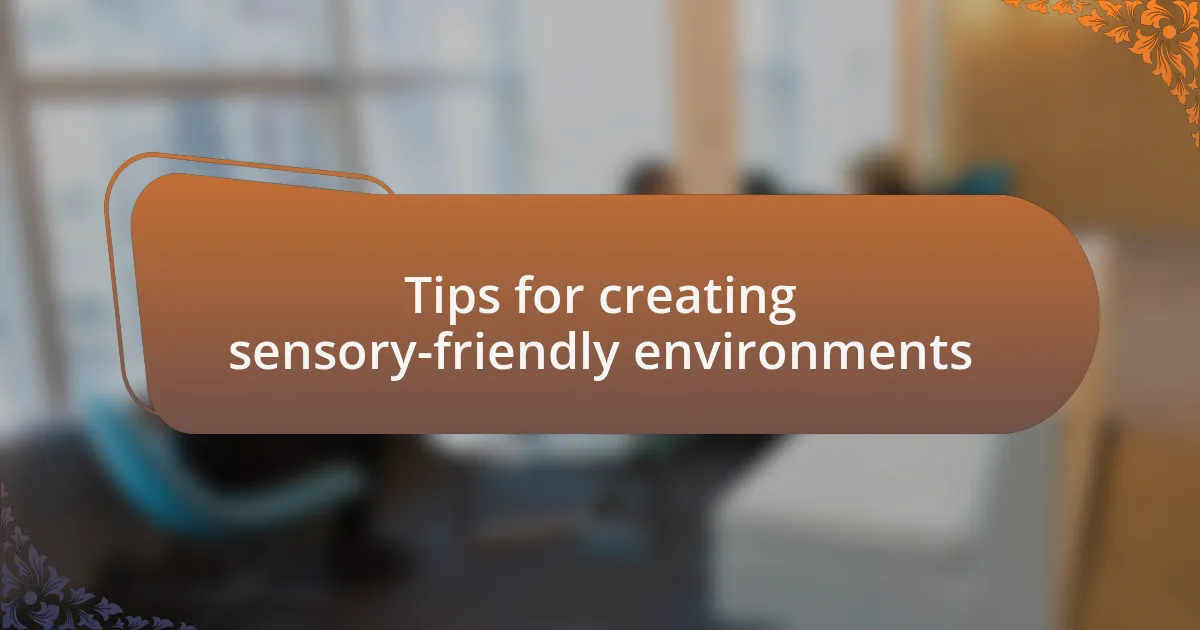
Tips for creating sensory-friendly environments
Creating a sensory-friendly environment is all about understanding individual needs. For instance, I once arranged a small gathering in my living room, deliberately using soft textures like plush cushions and knitted throws. It was amazing to see how everyone’s body language relaxed as they settled into that cozy space—could such simple changes make such a difference?
Another effective tip I’ve discovered is to limit auditory distractions. I recall a time when I hosted a movie night. Instead of the usual loud popcorn machine and chatter, I opted for a quiet popcorn maker and low-volume background music. People were able to engage more meaningfully and enjoy the movie without the anxiety that often accompanies a noisy setting. Have you tried adjusting the sound levels in your spaces?
Finally, incorporating natural elements can significantly enhance a room’s atmosphere. I often fill a corner with plants, which not only improve air quality but also create a calming effect. This was evident when I introduced a peace lily into my workspace; its presence helped me feel more grounded and focused. How does greenery impact your own perception of a space? Often, the right touch of nature can transform an environment from overwhelming to inviting.